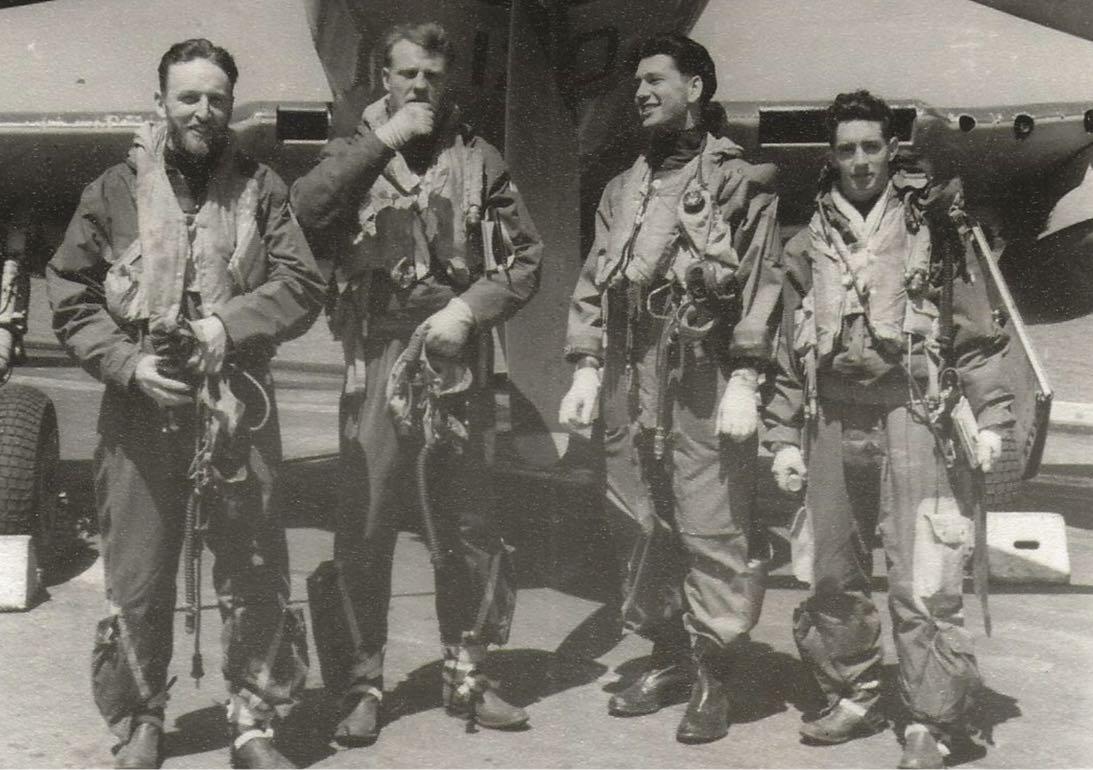
15 minute read
Aussies in
from FlyBy 71 July 2023
by SeaFury
The Colossus-class light fleet aircraft carrier Glory had maintained close ties toAustralia from her first commission in 1945, when senior officers of the Japanese Army and Navy surrendered to the 1st Australian Army’s LieutenantGeneral Vernon Sturdee CB DSO on her flight deck off Rabaul.
by Graeme Lunn
Advertisement
The end of 1951 found Glory alongside at Garden Island for refit after her arduous first deployment to Korea. In her nine war patrols before handing over to Sydney, she lost eight aircrew commencing with Lieutenant Edward Stephenson in his Sea Fury on her very first day of operations.
When Glory’s 14thCarrierAirGroupdisembarked for rest to Albatross/Naval Air Station Nowra on October 22nd, 1951, thirteen of the original twenty-nine pilots of 804 (Sea Fury) Squadron had been rotated back to the UK. Coupled with their losses over Korea, this left 804 needing more replacements than were readily available in the manpower pipeline. The RN posters were desperate and their roving eyes alighted on 767 Squadron of the 50thTrainingAir Group at Heron/ NavalAir Station Yeovilton.
767 was known as ‘the Clockwork Mouse’ squadron. They conducted training for Deck Landing Control Officers where the never-ending circuits and Aerodrome Dummy Deck Landings gaverisetothenickname.Ontemporarypostings to Heron in November 1951, flying those ADDLs responding to the trainee DLCO batting signals, were the three mostrecentRAN graduates ofOperational Flying School II (fighters) at Seahawk/ Naval Air Station Culdrose - Lieutenant Alan Cordell along with Acting Sub-Lieutenants Andrew Powell and Peter Wyatt.
They had just completed the required deck landings qualifications on the designated training carrier Triumph, returned from her 1950 Korean deployment.Andrew had led the way paired with an RN OFS course mate, Sub-Lieutenant ‘Oggie’ Swanson, completing his first four landings with a clear deckandbarriersdowninlessthanfifteenminutes. After that ‘easy’ introduction all following landingswereinnormaloperatingmodefacing a barrier and a forward deck park. Landings were filmed and Andrew, now 92 and living in Perth with his wife Margaret, still has a copy of those first landings. He also remembers the Commander (Air) at Heron, a flare-layer at Taranto who walked with a limp from a flight deck accident aboard Implacable, skilfully playing the piano in the wardroom after dinner. This was Commander Charles Lamb DSO DSC, author of the classic memoir ‘War in a Stringbag’.

Andrew and Peter had been Probationary Naval Aviators (Pilot) of No.4 Course, which had commenced in August 1949 at RAAF Base Point Cook. They were joined in February 1950 by three junior seaman officers who had first been appointed to the Royal Australian Naval College in 1942 aged thirteen. Having had some basic flying instruction during their Sub-Lieutenants Air Course with the RN, Alan Cordell, along with his classmates Peter Cabban and John Matthews, had successfully applied to sub-specialise in the new Air Branch. Posted to the UK for advanced training Alan graduated from fighter OFS in Sea Furies along withAndrew and Peter, while his two College classmates completed their Anti-Submarine OFS on Fireflies.
At this time a newly qualified pilot was not considered fully operational until he had undergone twelve months of rigorous work-up in a front-line squadron. As always, facing the urgent priorities of active operations, normal training parameters were varied to suit the needs of the moment. The three new Australian Sea Fury pilots were planned to take air passage to Australia with recent British OFS graduates to join 804 at Albatross. There they would have at least some weeks ashore to work up, as well as time during Glory’s passage north to the war zone.
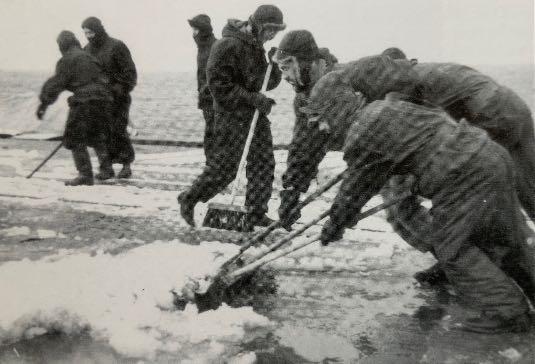
On December 13th, 1951, air passage toAustralia forAlan andAndrew was abruptly cancelled. Peter still flew home on December 15th, along with Oggie among the RN replacements, to join 804 ashore at Nowra. The next day Andrew and Alan found themselves sitting in first class aboard a BOAC Argonaut, bound for Tokyo. Traveling on to Kure they reported to HMAS Commonwealth and awaited Sydney’s return from her latest war patrol. 805 (Sea Fury) Squadron, one of three squadrons comprising the Sydney CAG, had sailed fromAustralia with twelve pilots. Sadly 805 now needed two replacements.
Inherthirdwarpatrol805’sSeniorPilot,Lieutenant ‘Nails’ Clarkson DFM, had been killed in action on November 5th, 1951. Hit while making a strafing run,hisaircraftwasobservedtorollonitsbackand dive into the ground. A month later on December 7th, the first days flying of Sydney’s fifth war patrol, Sub-Lieutenant ‘Dick’Sinclair was killed bailing out ofhisflakdamagedSeaFuryatlowlevel.Hisbody wasrecoveredandcommittedtothedeeponcompletion of the day’s flying.
Journey and Arrival
Andrew andAlan’s flight toTokyo was an adventure in itself. Suffering several cabin depressurisations along the way a full day was spent in Cairo while the engineers worked on the Argonaut. The runway at Rangoon was still the metal PSP or pierced steel planking of World War Two which made a worryingly loud and distinctive sound as the aircraft rolled over it. Departure from Rangoon was delayed with civil unrest in the airport vicinity and a nose wheel blowout in Hong Kong gave an unscheduled night stop.
As they disembarked in Tokyo the six Japanese passengers stood and bowed to Andrew and Alan insisting they disembark first. Issued with occupation money the British Officers Club appeared full of Americans spending lavishly on their Japanese girlfriends and it was onlyAmerican beer on tap. Being an occupied country uniform was always dress of the day but Andrews brightest memory was the food.After the austerity of post-war Britain the food was a veritable feast. ✈
Before Sydney arrived back from that fifth war patrol 805 had also almost lost their Commanding Officer, Lieutenant-Commander ‘Jimmie’ Bowles, as December 13th proved simultaneously lucky and unlucky. Lieutenant ‘Brassie’ Cooper of 808 (Sea Fury)Squadronhadbailedoutoverenemyterritory fromhisSeaFurythatmorning.Hewasrescuedby helicopter Pedro Fox, precariously based at Bromide Baker on the offshore island of PaengyongDojustbelowthe38thParallel.ThatafternoonJimmie was hit by the same guns that had shot down Brassie. Bailing out over water he was rescued by a friendly junk and later collected by the busy Pedro Fox which delivered both pilots to Tobruk. Blizzards prevented Jimmie and Brassie being transferred back to Sydney until December 16th. Arriving alongside in Kure on December 19th the patrol had been an arduous one with 383 sorties flown. Twenty aircraft made it back to the carrier with flak damage but five did not.
Alan andAndrew were warmly welcomed onboard by Lieutenant-Commander Richard How RN, who had been their Senior Naval Officer at Point Cook, and George Jude, now 805’s Senior Pilot. That Christmas week was celebrated with the concentratedintensityofyoungmenunderwartimestress. Sailing for her sixth war patrol on December 27th one squadron diarist wrote ‘It can be said without exaggeration that more than half the Squadron was relieved to be once again at sea and enjoy a little sobriety’.
Whenflyingoperationscommencedforthenewarrivals and the rest of the CAG on December 29th Sydney’s Air Group Commander, Lieutenant-Commander ‘Mike’ Fell DSO DSC MiD* RN (later ViceAdmiral Sir Michael Fell KCB), personally took the inexperienced aviators under his very capable wing.
Mike held the rare distinction of having shot down an enemy aircraft while flying an obsolescent Gloster Sea Gladiator biplane in 1940. He increased his score when he converted to Blackburn SkuasandyetagainflyingGrummanMartlets(F4F Wildcats) and Hawker Hurricanes when CO of the original RN 805 Squadron in the Western Desert. Mentioned-in-Despatches flying off the fleet carrier Illustrious protecting the Sicily landings, Mike was awarded an immediate DSO leading the second strike against the Tirpitz off the escort carrier Searcher. On that strike he deliberately drew flak away from his fellow pilots while scoring a low-level hit on the battleship.As Commander (Air) of the escort carrier Emperor Mike was Mentioned again during the invasion of Southern France, and received a DSC for operations in the Aegean where
Top. This Sea Fury has lost its wings in the barrier and caught fire. The firesuitman is clearing the flames from around the cockpit to allow the pilot, who is waiting patiently to escape. Middle. The Korean winter was brutal, with ice on the Flight Deck a constant hazard unless cleared by hand. Bottom. Two handlers, no doubt reminiscing about warmer weather in Australian waters, left behind a few months earlier. ✈ he orchestrated ‘the most destructively successful day that Emperor’s aircraft had since the ship was commissioned’.
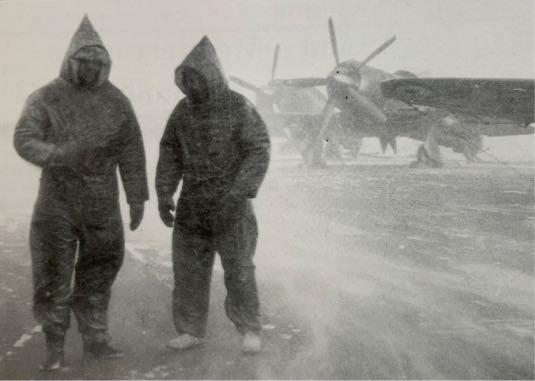
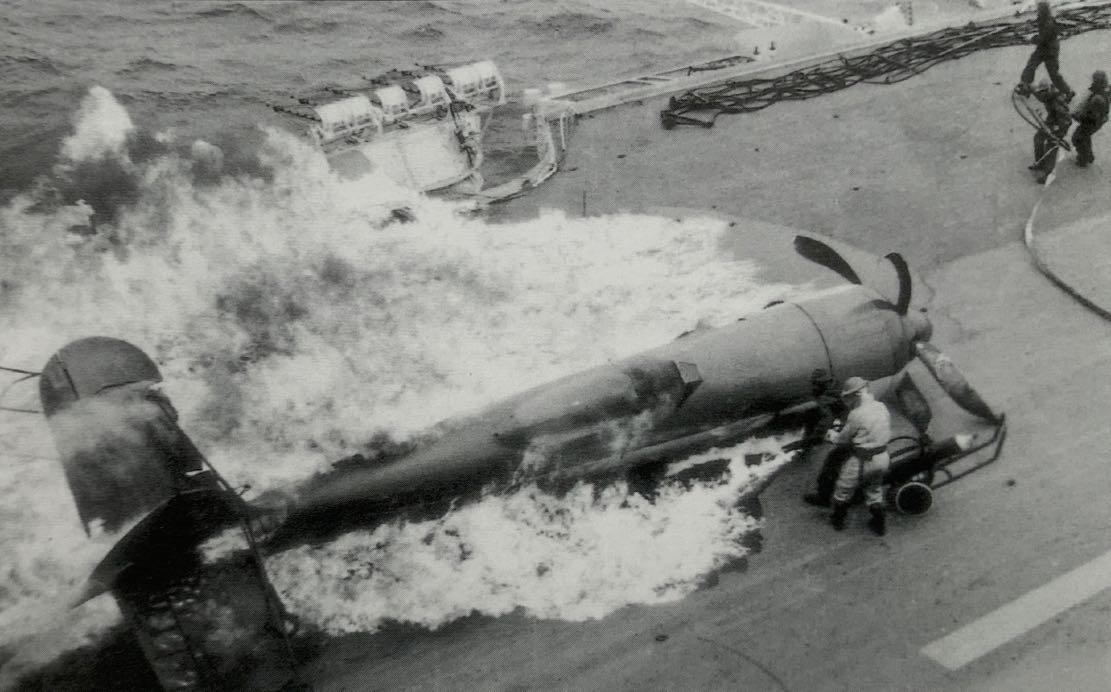
Andrew andAlan could not have had a more capable leader to learn from, which is just as well as they could not have been greener! The first time theylaunchedinafront-linesquadronwasalsothe first time they flew a Sea Fury with drop tanks, used rockets with explosive heads and live 20mm cannon shells, and was their first time in action. On his return from this sortie Andrew entered his twenty-first deck landing in his logbook. Daunting though it must have been,Andrew would only later modestly admit that it had been ‘a steep learning curve’. On January 2nd, 1952 805 lost their third pilot when Sub-Lieutenant ‘Ron’ Coleman was posted missing while flying a Combat Air Patrol in inclement weather.
Loading 500lb bombs by Jackstay Transfer.

Oggie’s First Crash
“In the last few days at Culdrose we were flying low level bomb runs with smoke bombs. The weather was pretty poor with the cloud base around 200 feet. Oggie arrived back for a lowlevel circuit flying upwind on the starboard side before breaking port and downwind to fit into the landing order. As he was about to break port the engine lost all power.
With a five bladed prop in fine pitch the Sea Fury’s gliding traits were akin to a brick dunny. Added to the problem was the fields around Culdrose seemed to represent pocket handkerchiefs with stone hedges built over centuries of farming. The only plus for Oggie was that he was already heading into wind. With the flaps down he landed straight ahead into a small field scant seconds after the engine failed.
moved to officer ranks for all aviators and 804 had seven commissioned pilots. It was a happy squadronwhereLieutenant-CommanderJohnBailey OBE, who had commanded 827 and 815 (Barracuda) Squadrons in World War Two, would smile indulgently when the commissioned pilots greeted him with a “Hi Boss, how are they hanging today.”
As the youngest and most junior Sea Fury pilot onboard Andrew still clearly recalls the lessons quicklyimpartedasMike’swingman.Themainemphasis was on low-level flying to avoid the heavy flak guns while accepting the added risk from light arms. Flying in battle formation the Sea Furies wouldcrossthecoastbetween5000’and6000’before striking their pre-briefed targets, followed by reconnaissance or photographic runs as required at low level. Winter had well and truly arrived by January 24th, when a temperature of 16ºF/-9ºC was recorded on the flight deck. The wind chill factor would have taken those figures to south of -2ºF/ -19ºC as sheets of ice over the barrier and wires were cleared away by shivering working parties. When exposed to these temperatures the Flight Deck Party could suffer from Frostbite in less than 30 minutes, if not careful.
With Andrew and Alan concentrating on their main tasks of armed reconnaissance, gunnery spotting, close air support and providing air cover over the fleet during Sydney’s sixth and seventh war patrols Peter and Oggie were hurriedly working up in 804 back at Albatross. Despite a break for Christmas it would have been a hectic two weeks before embarking on Glory in Jervis Bay on January 2nd, 1952.
Heading north Glory continued working up the numerous replacements in her two squadrons under a newAir Group Commander.This task was easier in 804 as both the CO and SP had remained, giving a continuity for the second deployment which 812 (Firefly) Squadron did not have. Stopping in Singapore, among the new aircraft, stores and ammunition loaded onboard was cold weather clothing.Itwouldbemuchappreciatedbytheflightdeck crew as the majority of the next five war patrols would be in the harsh Korean winter.
Before Glory entered Hong Kong Harbour on January 30th for handover from the waiting Sydney six RN Fireflies, borrowed by the Sydney CAG, were flown on. During the handover Alan and Andrew boarded Glory and joined Peter in 804 Squadron. Resuming the duties of a Blockading Force light fleet carrier Glory sailed from Hong Kong, via a refuelling stop in Sasebo, to be in the operational areaonFebruary6th. Withhalftheaircrewalready experienced with the routine of destroying bridges, tunnels, railway lines, villages and ox carts they quickly settled into this first war patrol despite the weather.
804 initially organised their twenty-two aircraft into five flights of four and one flight of two. The Australians were allocated individual Sea Furies with their names painted on them which aroused much interest and comment from the numerous visitors to the carrier observing flight operations. Alan flew in 12 Flight with the CO, Peter was in 14 Flight and Andrew was in 18 Flight as wingman to Commissioned Pilot ‘Mick’ Fieldhouse. The RN had not yet
His Sea Fury bounced and left the flaps behind and headed into the trees on the boundary. Good luck coupled with good flying saw the wings wiped off and the wreck came to a halt. The CO, who was in the circuit and witnessed the crash, entered the crew room and announced ‘Swanson is gone!’.
When the ambulance arrived to collect the dead body Oggie was in the kitchen drenched in Avgas, with a minor cut on his forehead, waiting for the farmers wife to finish brewing him a cup of tea. Oggie’s craggy looks had became a shade craggier. After some impatient time in hospital Oggie persuaded the medics that he was recovered enough to take passage for Nowra and 804 Squadron.”
Oggie is still alive and proud to have been No.4 in the Boss’ flight. A couple of years ago he had a
Couragewascommoncurrencyonbothsides.Diving to attack a railway bridge on the Haeju to Wongol rail line Andrew saw a solitary enemy soldier standing and returning fire with his rifle at the swooping flight of four Sea Furies with their sixteen cannon and multiple rockets firing at him. During Glory’s second war patrol Peter had his wing holed by a machine gun bullet at 4000’ - the highest then recorded for small arms fire. The same day asAndrew followed Mick in a strafing run three of the four aircraft were hit, Mick’s own close call being a .303 bullet passing through his canopy missing his head. Seventy years later Andrew has still not forgotten the distinctive and unpleasant sound of flak hitting his aircraft.
After a run of 424 accident free landings for Glory’s Air Group Andrew lost a tail wheel on the 425th which damaged the fuselage. Suffering his CO’s displeasure it also cost him a lot of ribaldry and drinks in the Wardroom. This patrol saw Glory’s 5,000th deck landing of the commission while eight pilots, including Mick Fieldhouse, had each now flown more than one hundred operational sorties. Mick’s experience included flying Seafire FR.47s
With the wheels of a departing Sea Fury barely off the deck, handlers of HMS Glory scurry to prepare the next aircraft for launching. The smooth operation of the Flight Deck required every single man to know exactly what he was doing, and to keep his wits about him. ✈
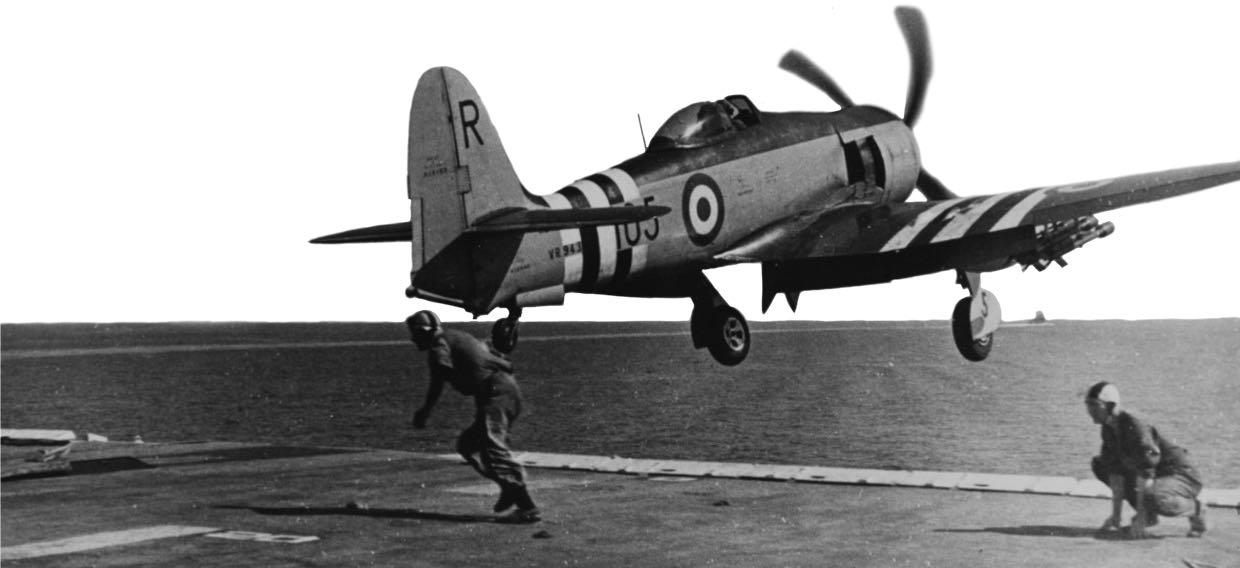
Ox Carts
Andrew would remember that if one found a good target on a TARCAP (Tactical Air Reconnaissance and CombatAir Patrol) it was often a flak trap. The pilots considered that the idea of Sea Furies taking out an oxcart seemed like an overly expensive exercise. In Andrew’s words “Yes, they blew up, but the value of the attackers versus what was achieved could not be cost effective. Perhaps that is how wars go!” Ox-carts, prime transport vehicles for the Communists, were opportunity targets only hunted after the sorties’ briefed targets had been attacked. Being so numerous, large quantities of supplies and ammunition could be moved in any weather over roads impassable to motor transport. In 39 flying days 804, among all their other targets, would record ox-cart attacks on 31 of them. The squadron destroyed 143 carts to 812’s score of 47, making an average of 5 per flying day.
Undoubtably disruptive to the enemy, since it was always a secondary target it was not the misuse of expensive resources as would first appear. In fact the carts were usually strafed while returning to the ship, using up any 20mm ammunition remaining.
No aircraft were lost from Glory while attacking ox-carts. ✈ off Triumph in 1950, so when he and Andrew coasted in they did so below 150 feet and in high speed cruise.This kept the low level Sea Fury relatively quiet and gave the advantage of surprise. ItwasduringthethirdwarpatrolonMarch17ththat Glory took back the record from Sydney for sorties in a day from a light fleet carrier while deterring an attack on Sok-to Island. Of the 106 sorties flown 804 flew sixty-five and 812 forty-one. The previous three days had seen a full flying programme so when each pilot of 804 flew three sorties, of about 2:30 hours each, by the time the last event landed on at sunset they were exhausted. The next day’s break for refuelling and replenishment provided some welcome aircrew rest. shelters. Close Air Support for the front-line troops was always popular, andAndrew relished one ground controller’s enthusiasm for his flights accuracy and punch as they bombed along a ridge line between smoke rocket markers.
With aircraft losses mounting, 804 reorganised into five flights of four. Alan moved to 17 Flight, Peter stayed in 14 Flight now led by the SP and Andrew moved to 15 Flight but still as wingman to Mick. Usual armament load was twelve 60lb rockets or two 500lb bombs. A normal bombing approach commenced with a high speed low-level (maximum 200 feet) track onto the target before pulling upto4000feet,rollingintoa45°diveandcentreing the target on the 6 o’clock pip of the gyro-gunsight. Releasing at 1500 feet the Sea Fury would bottom out of the attack run at around 800 feet, which could still be uncomfortably close to the blast if the fuses were set for direct contact or on an airburst setting to take out a flak position.
Onthefourthwarpatrolitwasdecidedthatthe60lb rockets were not giving enough bang to take out the gun positions built into the mainland cliffs opposite Cho-do island north of the 38th Parallel. Those guns covered an island which was important for pilot rescues so the Sea Furies were loaded with two 500 pounders fused for a 30 second delay, allowing a dive to a lower altitude with increased accuracy. The gun positions were destroyed over several days with Andrew finishing the task by taking out their observation tower. The squadron’s dive bombing improved rapidly against other targets, and even the odd bridge span was dropped in emulation of their Firefly colleagues in 812.
Taken on the day that HMS Glory won back the record for the most sorties in a day (with 105), this image gives an idea of how busy the Flight Deck could be when strikes were programed. (17 Mar 1952). ✈
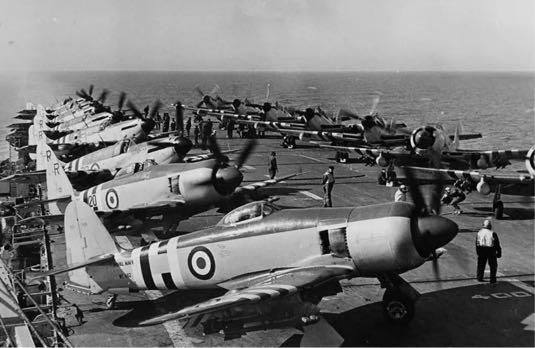
On Glory’s final war patrol in April 1952 a fourth RAN aviator joined 804. Lieutenant Martin Scott, who had been a RNVR Miles Martinet target tug pilot at the end of World War Two, had finished his fighter OFS that February and joined 802 (Sea Fury) Squadron aboard Ocean. After only five weeks in the Mediterranean he took air passage to Japan to temporarily fly from Glory. Martin quickly demonstrated his accuracy when, onApril 24th, he and the SP obtained direct hits on camouflaged
As Glory withdrew there was pride in her achievements over two deployments and fourteen war patrols. Despite enemy fire, frequent snowstorms and many RATOG launches due to catapult unserviceability there had only been one further aircrew loss in the second deployment. Lieutenant Overton’s Sea Fury was hit by fire from at least five guns during a low photographic and strafingrunoverthenotoriouslydangerousAmgak peninsula on March 15th.
One hundred and forty aircraft had returned damaged to Glory and twenty-seven were lost. There had been only fourteen landing accidents in 4,838 deck landings, with the last 939 deck landings accident free. Nine aircrew had lost their lives, one was wounded and twenty-four had been rescued.
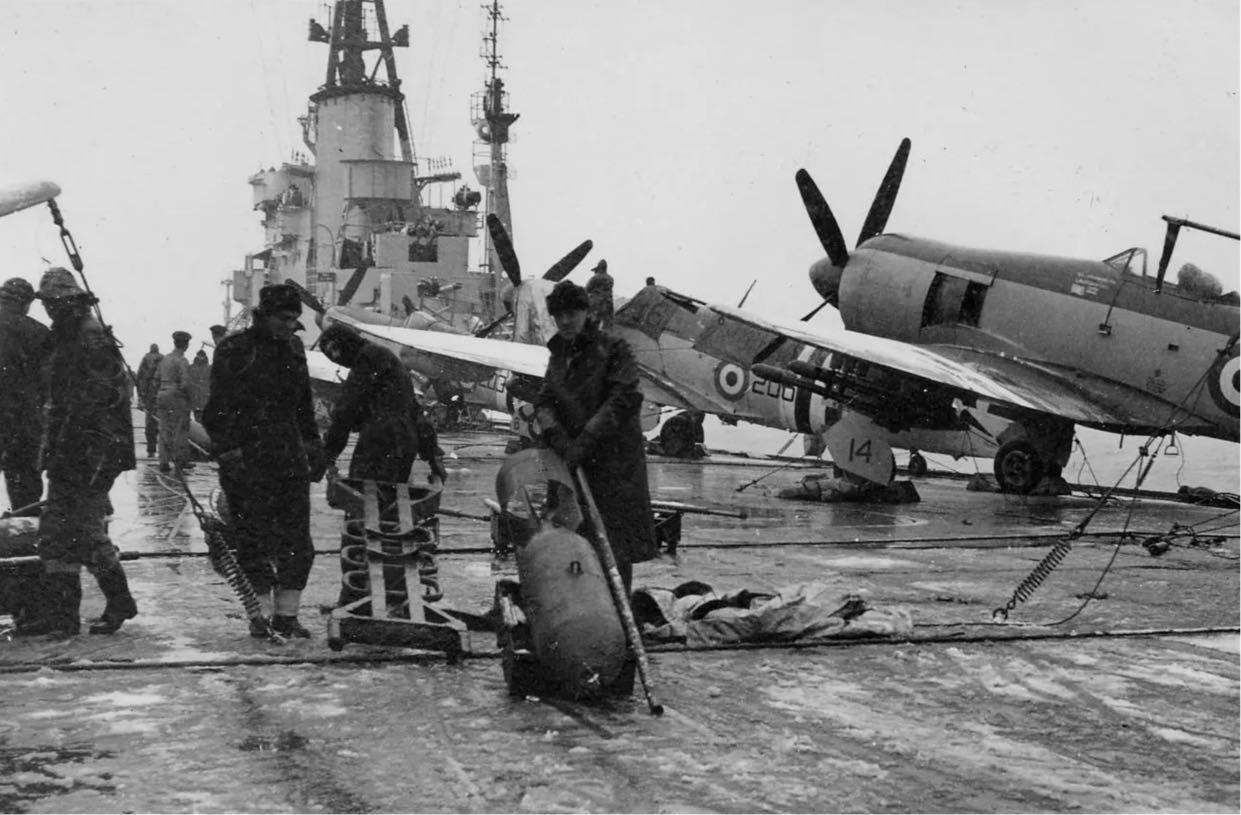
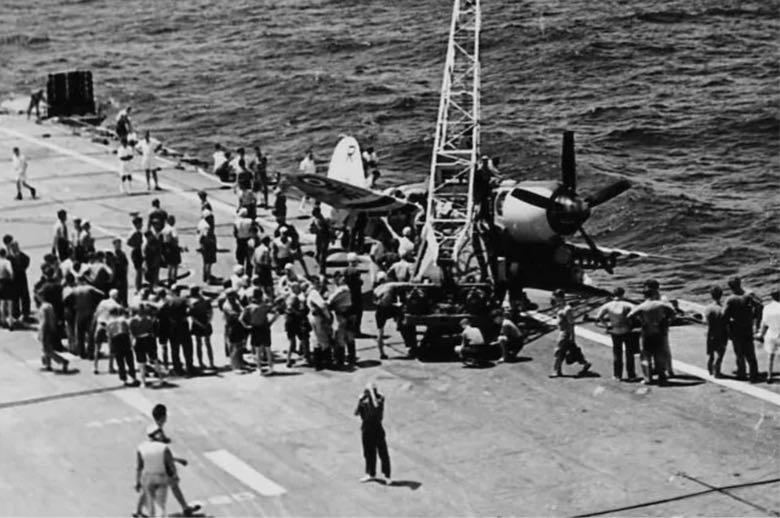
Glory was still to conduct a third deployment which saw her lose another twelve aircrew in a further eleven war patrols. Her ships battle honour board commenced with ‘Glorious 1st June 1794’ and it now ended with the hard-earned ‘Korea 1950-53’.
Jimmie Bowles and John Bailey received DSCs with Mike Fell gaining a bar to his DSC. Mick Fieldhouse was Mentioned-in-Despatches. When Glory handed over her duties to Ocean on May 3rd,
1952, Martin rejoined 802 Squadron aboard her. Accompanied by Oggie and three other 804 pilots they provided a base of operational experience.
Oggie, who had crash landed on an offshore island and later ditched after flak damage while with 804, was shot down on Ocean’s second war patrol. Jumping from his burning, tailless Sea Fury his parachute opened just before he hit the water. Rescued under fire by a helicopter from Cho-dohewasreturnedto Ocean aftertreatment for minor burns. Having previously crashed while flying out of Culdrose (see side bar earlier in this article) this made him four Sea Furies down and facing jocular accusations of aspiring to be that rarest of aviators - a reverse ace!



Flying CAP on Ocean’s first war patrol, Martin suffered a cockpit fire forcing him to ditch. Rescued by the USN destroyer Lowry his burnt hands meant time in sick bay and a long period ashore in hospital. He talked his way into a discharge and return to A1 flying status, rejoining 802 inAugust and flying another four war patrols.
With Glory alongside in SingaporeAndrew, Peter andAlan disembarked on May 21st, 1952. When the carrier headed for Malta they returned toAustralia by liner for well earned leave before joining 808 (Sea Fury) Squadron.
While awaiting the modernisation of Majestic/ Melbourne the Colossus-class Vengeance was loaned to the RAN for several years. She arrived at Sydney in March 1953 with a steaming party that included Martin, who had taken passage hometoAustraliawithher.HewasappointedSenior Pilot of 808 and the squadron embarked on Vengeance in September 1953.
Alan spent 1953 on the staff at the Royal Australian Naval College before being one of the first to convert to jets at RAAF Base Williamtown. Briefly with 723, he went on to a Night Fighter Course with the RN later in 1954. That was the year of the new Queen’s Royal Visit to Australia where 817 (Firefly) and 808 Squadrons flew several ‘E’formations in her honour. Coping with the swaying at the bottom of the long bar took an experienced light touch on the controls. Making up the bottom bar on those formations were Martin, Peter andAndrew.
Alan Cordell, Andrew Powell, Martin Scott and PeterWyattwereourAussiesin Glory where,despite their initial inexperience, they took full measure of courage to add to the proud history of the RAN’s FleetAirArm. ✈
